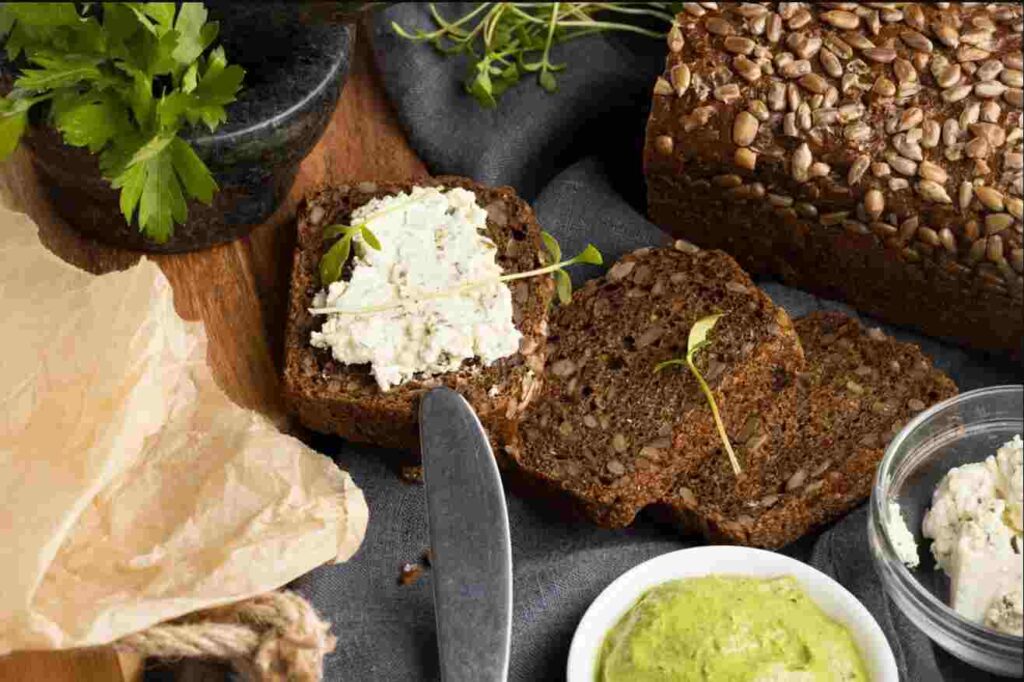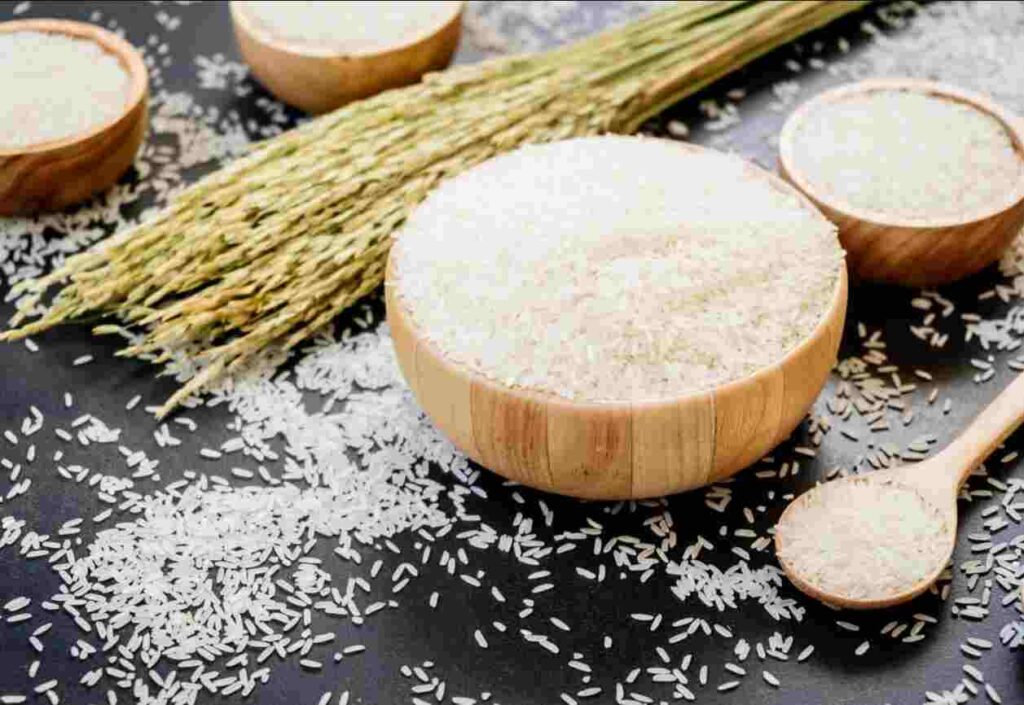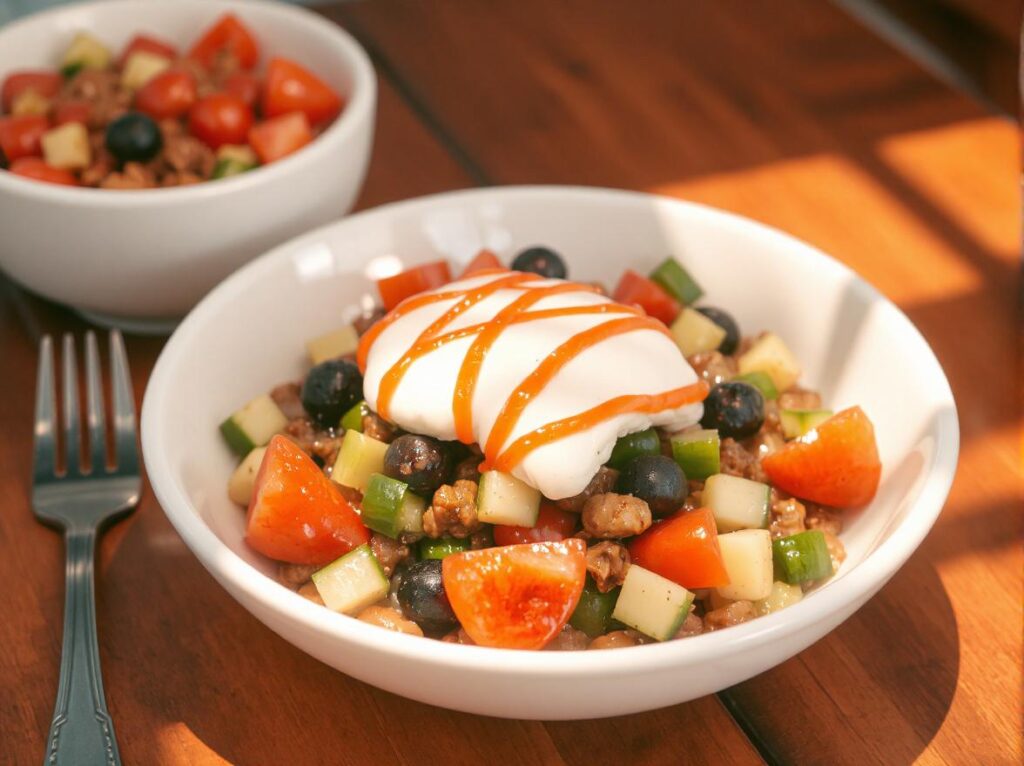Few dishes spark as much passion and debate as jollof rice. From lively kitchen rivalries between Nigeria and Ghana to its status as a staple at West African celebrations, this iconic dish holds a special place in many cultures. Loved for its bold flavors, rich tomato base, and aromatic spices, jollof rice is more than just a meal—it’s a cultural experience.
But beyond its irresistible taste, a common question arises: Is jollof rice healthy? Whether you’re considering it for weight loss, managing diabetes, or simply making healthier food choices, understanding its nutritional profile is key.
In this article, we’ll break down the nutrition facts, health benefits, and potential drawbacks of jollof rice, as well as tips for making a healthier version.
Nutritional Breakdown of Jollof Rice
The nutritional value of jollof rice depends on the ingredients used and portion sizes. A standard serving (1 cup or about 200 grams) of traditional Nigerian jollof rice provides approximately:
- Calories: 250–350 kcal
- Carbohydrates: 45–55g
- Protein: 5–8g
- Fats: 7–15g
- Fiber: 2–4g
- Sodium: 300–600mg (varies based on seasoning and broth used)
Jollof rice is a carbohydrate-rich dish, which provides energy, but the calorie count can increase significantly depending on the type of oil, protein additions, and serving size. To make it healthier, portion control and ingredient adjustments can help manage calorie intake.
Jollof Rice Ingredients Nutrition
The health benefits of jollof rice largely come from its core ingredients:
Rice (White or Brown) – A primary source of energy, but brown rice offers more fiber and micronutrients, making it a better option for digestion and blood sugar control.
Tomatoes – Packed with vitamin C, lycopene (an antioxidant), and potassium, tomatoes support heart health and immunity.
Onions & Garlic – Contain antioxidants, anti-inflammatory compounds, and vitamins, which help boost immunity and regulate blood pressure.
Bell Peppers – Rich in vitamin A, vitamin C, and fiber, they support eye health and digestion.
Spices (Thyme, Bay Leaves, Curry Powder, Ginger, etc.) – Offer various anti-inflammatory and digestive benefits.
Vegetable or Palm Oil – Provides healthy fats but should be used in moderation to prevent excess calorie intake.
Health Benefits of Jollof Rice

Jollof rice isn’t just a beloved West African dish; it also provides essential nutrients that can contribute to a balanced diet. While its healthiness depends on preparation methods and portion sizes, it contains fiber, vitamins, and minerals that offer several benefits.
Jollof Rice Health Benefits
Rich in Antioxidants – The tomatoes, onions, and bell peppers in jollof rice are excellent sources of vitamin C, lycopene, and beta-carotene, which help protect cells from damage, reduce inflammation, and support immune health.
Supports Digestive Health – If prepared with brown rice or additional vegetables, jollof rice provides fiber that aids digestion, prevents constipation, and supports gut health.
Energy-Boosting Carbohydrates – Rice is a quick energy source, making jollof rice a good option for those needing sustained energy, especially when combined with lean proteins for balance.
Heart Health Benefits – The use of garlic, onions, and healthy oils (like olive or sunflower oil) may help lower cholesterol and support cardiovascular health.
Protein-Packed When Paired with Meat or Fish – Adding chicken, beef, fish, or beans makes jollof rice a more protein-rich meal, supporting muscle growth and repair.
Jollof Rice Benefits for Diabetics
For diabetics, jollof rice can be part of a balanced diet if prepared with certain modifications:
Use Brown Rice Instead of White Rice – Brown rice has a lower glycemic index (GI), which means it doesn’t spike blood sugar levels as quickly as white rice.
Reduce Oil and Fat Content – Limiting the use of palm oil or heavy oils helps control calorie intake and improves heart health.
Incorporate More Vegetables – Adding spinach, carrots, green beans, or bell peppers increases fiber, which helps slow down sugar absorption in the bloodstream.
Watch Portion Sizes – A smaller serving (about ½ cup of cooked rice) paired with protein and fiber-rich vegetables can help maintain stable blood sugar levels.
Is Jollof Rice Good for You?
Yes, jollof rice can be good for you when prepared with balanced ingredients and mindful portions. It provides essential nutrients and can be part of a healthy diet. However, traditional versions high in oil, sodium, or white rice can contribute to weight gain or blood sugar spikes if consumed in excess.
To make jollof rice a healthier meal choice:
Use brown rice or quinoa for more fiber.
Reduce oil and opt for heart-friendly oils like olive or canola.
Add more vegetables for extra vitamins and fiber.
Control portion sizes to manage calorie and carbohydrate intake.
Is Jollof Rice Healthy for Weight Loss?
Jollof rice is a high-carb dish, which means it can be a part of a weight loss diet if consumed in moderation and prepared with healthier ingredients. While traditional jollof rice can be calorie-dense due to oil, white rice, and high-sodium seasonings, there are ways to make a lighter version that supports weight management.
Is Jollof Rice Healthy for Weight Loss?
Yes, jollof rice can be suitable for weight loss if you focus on portion control, ingredient choices, and preparation methods:
Control Portion Sizes – Instead of eating a large plate, stick to ½–1 cup of cooked jollof rice and pair it with lean protein (chicken, fish, beans) and fiber-rich vegetables to stay full longer.
Use Brown Rice or Alternative Grains – Brown rice, quinoa, or cauliflower rice are lower glycemic index options that provide more fiber and help control hunger.
Reduce Oil Content – Traditional jollof rice recipes use a lot of oil, which adds unnecessary calories. Use less oil or opt for heart-healthy oils like olive oil instead of palm oil.
Add More Vegetables – Bulk up the dish with bell peppers, spinach, green beans, or carrots to increase fiber and make the meal more filling without extra calories.
Limit High-Calorie Additions – Avoid excessive butter, fried meats, or processed seasonings that add extra fat and sodium.
Healthy Jollof Rice Recipe for Weight Loss
Here’s a lighter, lower-calorie version of jollof rice:
Ingredients:
- 1 cup brown rice or quinoa
- 2 medium tomatoes, blended
- 1 small onion, chopped
- 1/2 cup bell peppers, chopped
- 1 teaspoon olive oil (instead of palm oil)
- 1 teaspoon ginger and garlic paste
- 1 teaspoon paprika and thyme
- 2 cups low-sodium vegetable broth or water
1 cup lean protein (grilled chicken, fish, or beans)
Instructions:
Heat 1 teaspoon of olive oil in a pan and sauté onions, garlic, and ginger.
Add blended tomatoes and bell peppers, cooking until the sauce thickens.
Stir in spices (paprika, thyme) and low-sodium broth.
Add brown rice or quinoa, cover, and simmer until cooked.
Mix in lean protein and extra vegetables for added nutrients.
Is Jollof Rice Healthy to Eat Every Day?
Jollof rice is a nutritious and flavorful dish, but is it healthy to eat every day? While it offers essential nutrients like carbohydrates, vitamins, and antioxidants, consuming it too frequently without balance may have drawbacks.
Is Jollof Rice Healthy to Eat Every Day?
Pros of Eating Jollof Rice Regularly:
Provides Energy – The rice in jollof rice is a great source of carbohydrates, fueling daily activities.
Rich in Nutrients – Ingredients like tomatoes, onions, and bell peppers provide vitamins A, C, and antioxidants that support overall health.
Versatile and Customizable – You can adjust the ingredients to make it healthier, such as using brown rice, lean protein, and less oil.
Cons of Eating Jollof Rice Every Day:
High in Carbohydrates – Eating rice-based meals daily, especially with white rice, may contribute to blood sugar spikes and weight gain if not paired with enough protein and fiber.
Oil Content Matters – Traditional jollof rice recipes use a lot of oil, which can increase calorie intake and may not be ideal for heart health if consumed excessively.
Lack of Dietary Variety – A balanced diet should include different grains, proteins, and vegetables to provide all necessary nutrients.
Is Jollof Rice Spicy?
Jollof rice can be spicy, depending on how it is prepared. Nigerian jollof rice is often made with scotch bonnet peppers, which add significant heat, while Ghanaian jollof tends to have a milder spice level.
How Spiciness Affects Digestion:
Some people tolerate spicy foods well, while others may experience heartburn, acid reflux, or stomach irritation.
If you have sensitive digestion, reduce the heat by using milder peppers (bell peppers, sweet paprika) or adjusting the quantity of spicy ingredients.
Is Jollof Rice Healthy in Nigeria?
Jollof rice is more than just a dish in Nigeria—it’s a cultural staple enjoyed at home, at parties, and during celebrations. But how healthy is it in the Nigerian context? The nutritional value of jollof rice in Nigeria depends on ingredients, preparation methods, and portion sizes.
Is Jollof Rice Healthy in Nigeria?
How Nigerians Consume Jollof Rice
Jollof rice is often eaten as a main meal, typically served with fried or grilled meats (chicken, beef, or fish), fried plantains, and sometimes salad.
It is commonly prepared with palm oil or vegetable oil, which affects its calorie and fat content.
Many Nigerians eat jollof rice at least once a week, either homemade or from restaurants and street vendors.
Health Considerations in Nigeria
Benefits:
Fresh ingredients like tomatoes, peppers, onions, and garlic provide antioxidants, vitamins, and minerals.
If paired with grilled fish or chicken and vegetables, it can be a balanced meal.
When made with brown rice, it provides more fiber for better digestion.
Concerns:
Some versions are high in oil and salt, which may contribute to weight gain or high blood pressure if consumed excessively.
Many people pair it with fried sides (e.g., fried plantains, fried meats), increasing calorie intake.
Eating large portions of white rice regularly can lead to blood sugar spikes, especially for diabetics.
Ingredients for Jollof Rice in Nigeria
While jollof rice is enjoyed across West Africa, Nigerian jollof has distinct characteristics in its ingredients and preparation:
Common Ingredients in Nigerian Jollof Rice:
Rice – Traditionally made with long-grain parboiled rice, but some opt for basmati or brown rice for a healthier version.
Tomatoes & Tomato Paste – Provides lycopene, an antioxidant that supports heart health.
Red Bell Peppers & Scotch Bonnet Peppers – Adds vitamin C and spice, enhancing flavor.
Onions & Garlic – Known for immune-boosting properties and digestive benefits.
Vegetable Oil or Palm Oil – Palm oil contains vitamin A but should be used in moderation due to its saturated fat content.
Stock & Seasonings – Includes thyme, bay leaves, curry powder, bouillon cubes, which add depth of flavor.
Protein Options – Grilled or fried chicken, beef, fish, or shrimp often accompany the dish.
How to Make Nigerian Jollof Rice Healthier
Use brown rice or basmati rice instead of white rice.
Reduce oil content and use heart-friendly oils like olive or sunflower oil.
Add more vegetables like carrots, peas, or green beans for extra fiber.
Pair with grilled instead of fried proteins.
Public Opinion on Jollof Rice Health

With the growing emphasis on healthy eating, many people turn to online forums like Reddit to discuss the health aspects of their favorite dishes—including jollof rice. Conversations about jollof rice on Reddit’s nutrition, fitness, and food communities reveal a mix of opinions from health-conscious individuals, nutritionists, and food lovers.
Is Jollof Rice Healthy? What Reddit Users Say
Reddit discussions about jollof rice often center around nutrition, weight loss, and meal customization. Here are some common perspectives:
Jollof Rice Can Be Healthy If Prepared Right
Many users believe that jollof rice is as healthy as the ingredients used. A common opinion is:
“If you make it with brown rice, use less oil, and add lean protein, it can be a great balanced meal!”
Concerns About Oil and White Rice
Some fitness and nutrition-focused users warn against excessive oil use and white rice consumption:
“Restaurant jollof can be super oily. If you’re trying to lose weight, be mindful of portion sizes and cook it yourself.”
Jollof Rice for Weight Loss and Fitness Diets
Bodybuilders and fitness enthusiasts discuss ways to incorporate jollof rice into their meal prep:
“I eat jollof rice after workouts because it’s a good carb source, but I control portions and pair it with grilled chicken.”
Diabetes and Blood Sugar Concerns
People with diabetes or those following a low-carb diet often debate whether jollof rice is suitable for them:
“I switched to brown rice and added more veggies to my jollof, and my blood sugar levels have been better.”
The Debate Over Spicy Food and Digestion
Some users discuss whether the spiciness of jollof rice affects digestion, with mixed experiences:
“I love spicy jollof, but it gives me heartburn. I tone down the spice with milder peppers.”
Reddit Discussions
Jollof rice is widely loved, but its healthiness depends on ingredients and portion control.
Making it at home is preferred over restaurant versions due to better control over oil and sodium.
Fitness enthusiasts recommend pairing it with lean protein and vegetables for a balanced meal.
Diabetics and weight-conscious individuals modify recipes by using brown rice or quinoa.
Spice levels vary, and those with sensitive digestion may need to adjust accordingly.
Final Thoughts and Conclusion
Jollof rice is a beloved West African dish that offers several health benefits, including fiber, vitamins, and antioxidants from ingredients like tomatoes, onions, and bell peppers. When paired with lean proteins and vegetables, it can be a nutritious and well-rounded meal. However, there are concerns about its calorie content, oil use, and high-carb nature, especially when consumed in large portions or made with white rice and excessive oil.
That said, when prepared thoughtfully, jollof rice can fit into a healthy diet. By choosing brown rice or quinoa, reducing oil, and incorporating more vegetables, you can enjoy a lighter version that still retains its rich flavors.
Ultimately, moderation is key. Whether you’re aiming for weight loss, managing diabetes, or just trying to eat more balanced meals, customizing your jollof rice recipe to suit your health goals can make it a nourishing, satisfying dish that you can enjoy regularly.




























